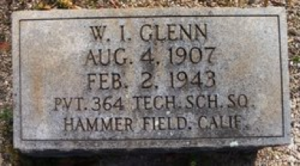Scroll of Honor – Wallace Irvin “Red” Glenn
One In Sixteen Million
It happened fast but despite a flurry of activity in 1941 America was still unprepared for war. As a result, the military accelerated its base-building efforts in the wake of the Japanese attack on Pearl Harbor. One of the bases that had been established as the country scrambled to train, equip and deploy the sixteen million soldiers, sailors, airmen and Marines who would serve in World War II was Hammer Field near Fresno, California. At age thirty-five, Red Glenn was surely one of the older privates on the base.

Wallace Irvin “Red” Glenn, Class of 1929, was a member of Company F in the 2nd Battalion of the Clemson College Corps of Cadets.
Wallace Irvin “Red” Glenn graduated from Greenwood High School and enrolled in Clemson College in 1925. Glenn, an architecture major, was assigned to Company F, 2nd Battalion of the Corps of Cadets. Glenn attended Clemson for only his freshman year.
Following the December 7, 1941 attack by the Japanese, the Roosevelt administration was faced with the daunting task of converting the world’s largest economy from a peacetime, consumer-oriented one into the “Arsenal of Democracy” that would provide the men, machines and materiel that would win the war. Part of that conversion was the induction into the armed forces and the training of millions of young men, many of whom had never left their native states. Now, the demands of a nation at war saw these same young men—and some a little older—shipped to every region of the country.
Red Glenn found himself assigned to the Army Air Forces Flying Training Command at Hammer Field. The mission of the 4th Air Force Replacement Depot there was to train replacement pilots, aircrew and ground personnel for what would become the largest Air Force in the world. Fliers and technicians from all over the United States would pass through the base for training enroute to assignments overseas. Eventually, Hammer Field’s mission expanded beyond aircrews to include Air Force nurses.
Glenn, a ground support crewman at the base, would have been engaged in keeping the base’s many training aircraft in flight-worthy condition. Following “several weeks” of illness, Glenn died at the Hammond General Hospital in nearby Modesto on February 2, 1943. He was survived by his father and step-mother. His body was returned to Greenwood and he was buried in Edgewood Cemetery.
For additional information about Wallace Irvin Glenn see:
https://soh.alumni.clemson.edu/
For more information about Clemson University’s Scroll of Honor visit:
